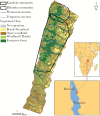Feeding habitat quality and behavioral trade-offs in chimpanzees: a case for species distribution models
- PMID: 27418751
- PMCID: PMC4943107
- DOI: 10.1093/beheco/arw004
Feeding habitat quality and behavioral trade-offs in chimpanzees: a case for species distribution models
Abstract
The distribution and abundance of food resources are among the most important factors that influence animal behavioral strategies. Yet, spatial variation in feeding habitat quality is often difficult to assess with traditional methods that rely on extrapolation from plot survey data or remote sensing. Here, we show that maximum entropy species distribution modeling can be used to successfully predict small-scale variation in the distribution of 24 important plant food species for chimpanzees at Gombe National Park, Tanzania. We combined model predictions with behavioral observations to quantify feeding habitat quality as the cumulative dietary proportion of the species predicted to occur in a given location. This measure exhibited considerable spatial heterogeneity with elevation and latitude, both within and across main habitat types. We used model results to assess individual variation in habitat selection among adult chimpanzees during a 10-year period, testing predictions about trade-offs between foraging and reproductive effort. We found that nonswollen females selected the highest-quality habitats compared with swollen females or males, in line with predictions based on their energetic needs. Swollen females appeared to compromise feeding in favor of mating opportunities, suggesting that females rather than males change their ranging patterns in search of mates. Males generally occupied feeding habitats of lower quality, which may exacerbate energetic challenges of aggression and territory defense. Finally, we documented an increase in feeding habitat quality with community residence time in both sexes during the dry season, suggesting an influence of familiarity on foraging decisions in a highly heterogeneous landscape.
Keywords: animal ecology; environmental heterogeneity; habitat selection; primate behavior; species distribution models..
Figures






References
-
- Amici V, Geri F, Bonini I, Rocchini D. 2014. Ecological niche modelling with herbarium data: a framework to improve Natura 2000 habitat monitoring. AEER. 12:645–659.
-
- Amsler SJ. 2010. Energetic costs of territorial boundary patrols by wild chimpanzees. Am J Primatol. 72:93–103. - PubMed
-
- Aureli F, Schaffner CM, Boesch C, Bearder SK, Call J, Chapman CA, Connor R, Di Fiore A, Dunbar RI, Henzi SP. 2008. Fission-fusion dynamics. Curr Anthropol. 49:627–654.
-
- Avgar T, Mosser A, Brown GS, Fryxell JM. 2013. Environmental and individual drivers of animal movement patterns across a wide geographical gradient. J Anim Ecol. 82:96–106. - PubMed
-
- Bates LA, Byrne RW. 2009. Sex differences in the movement patterns of free-ranging chimpanzees (Pan troglodytes schweinfurthii): foraging and border checking. Behav Ecol Sociobiol. 64:247–255.
LinkOut - more resources
Full Text Sources
Other Literature Sources

